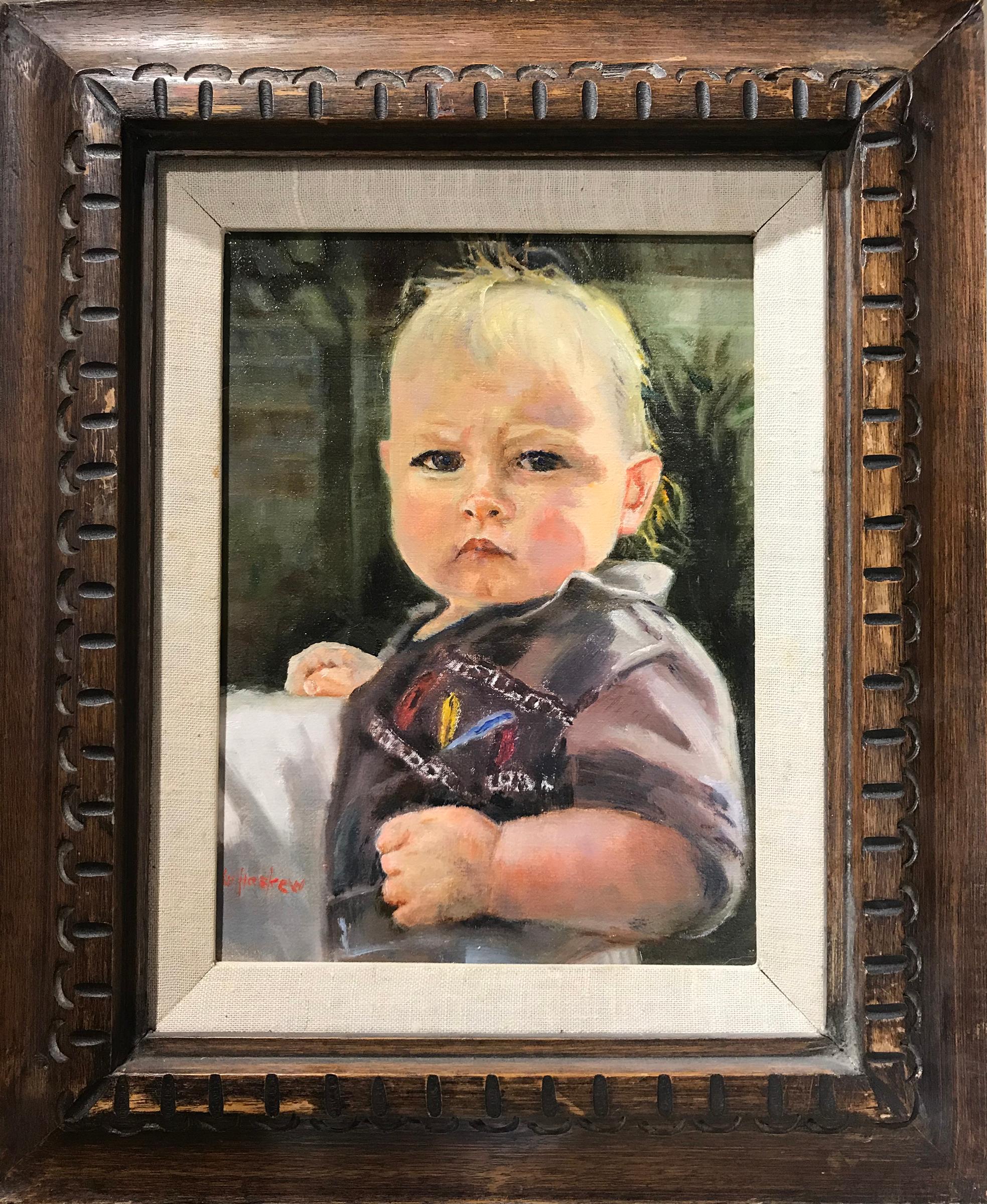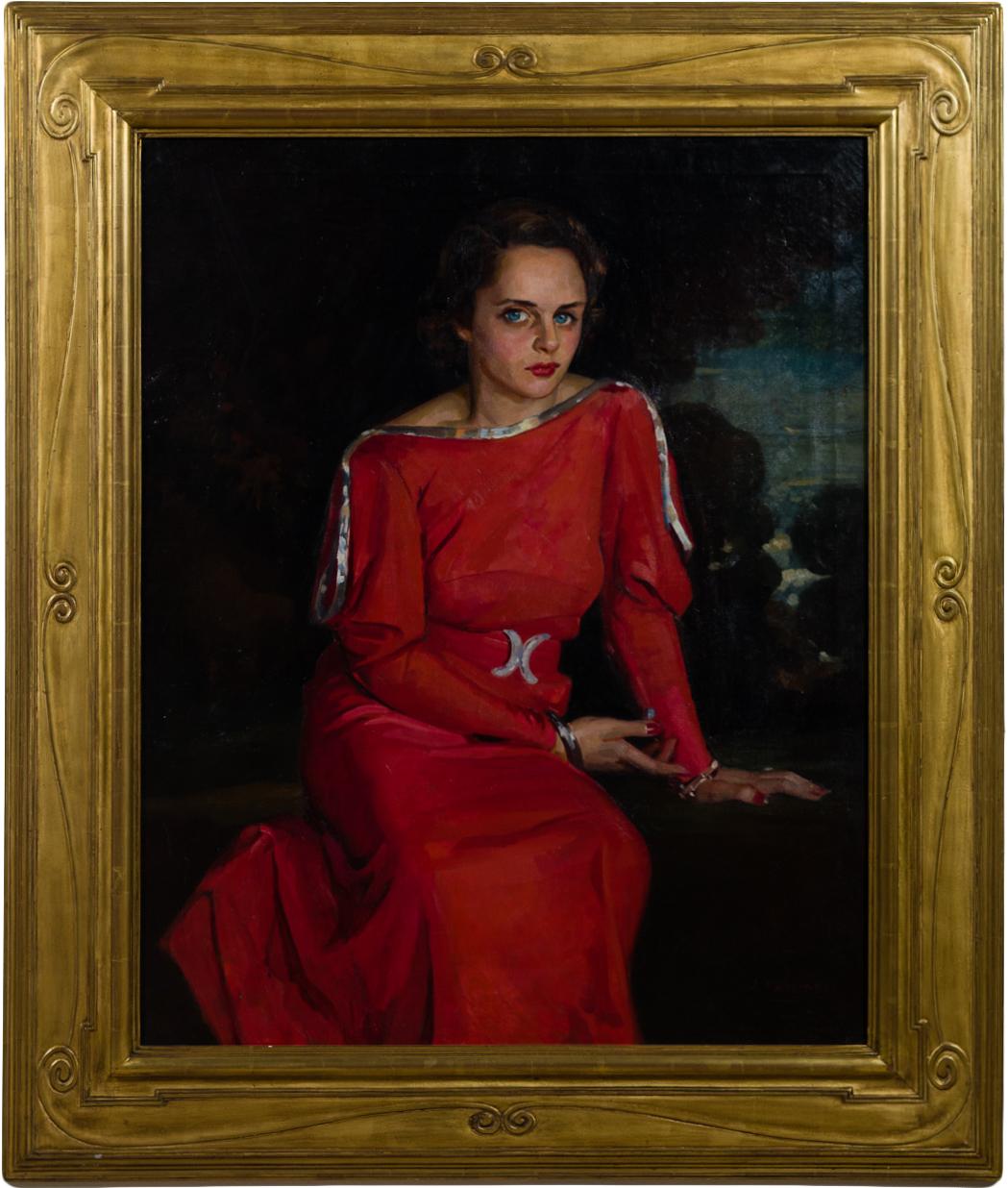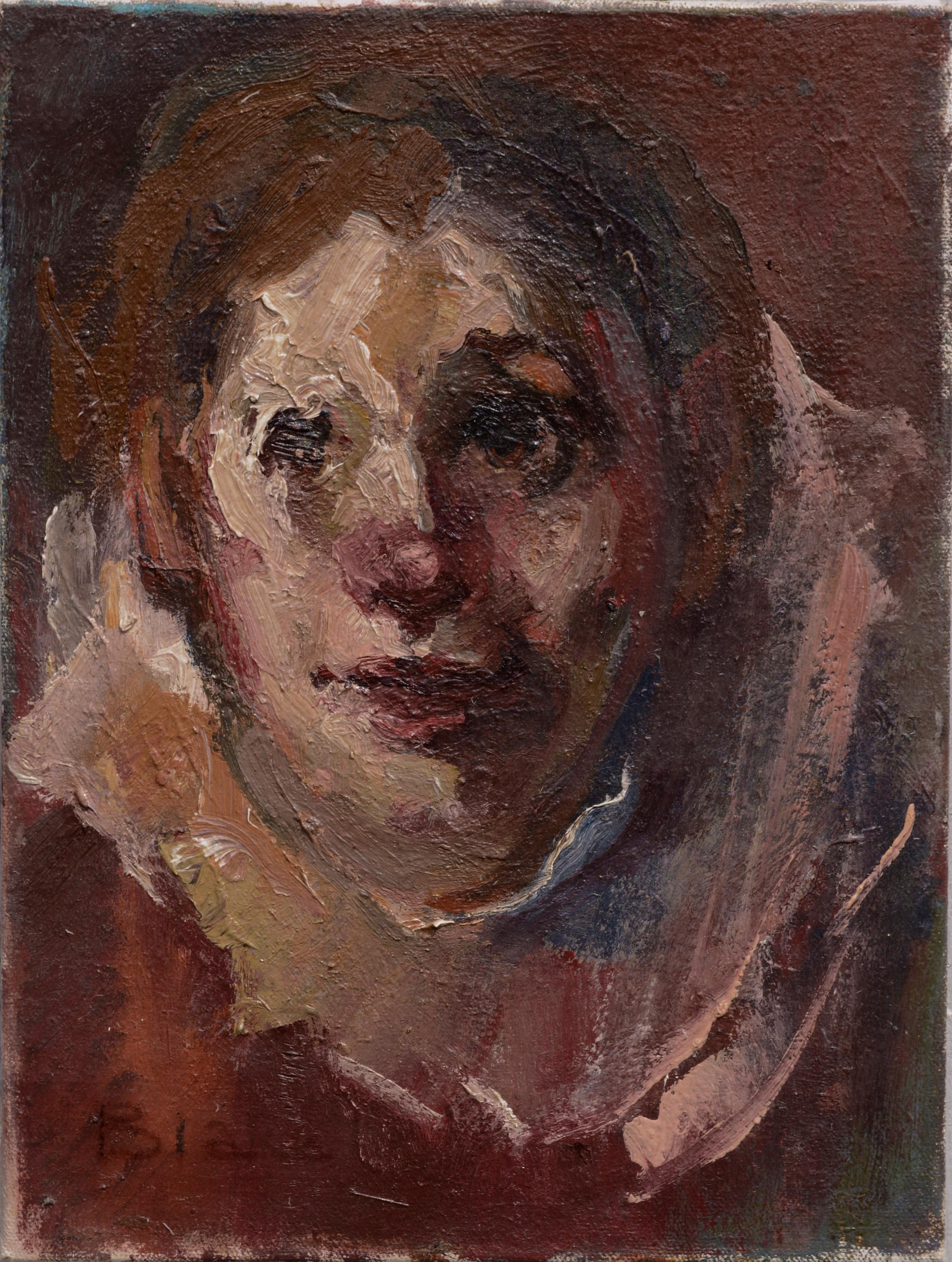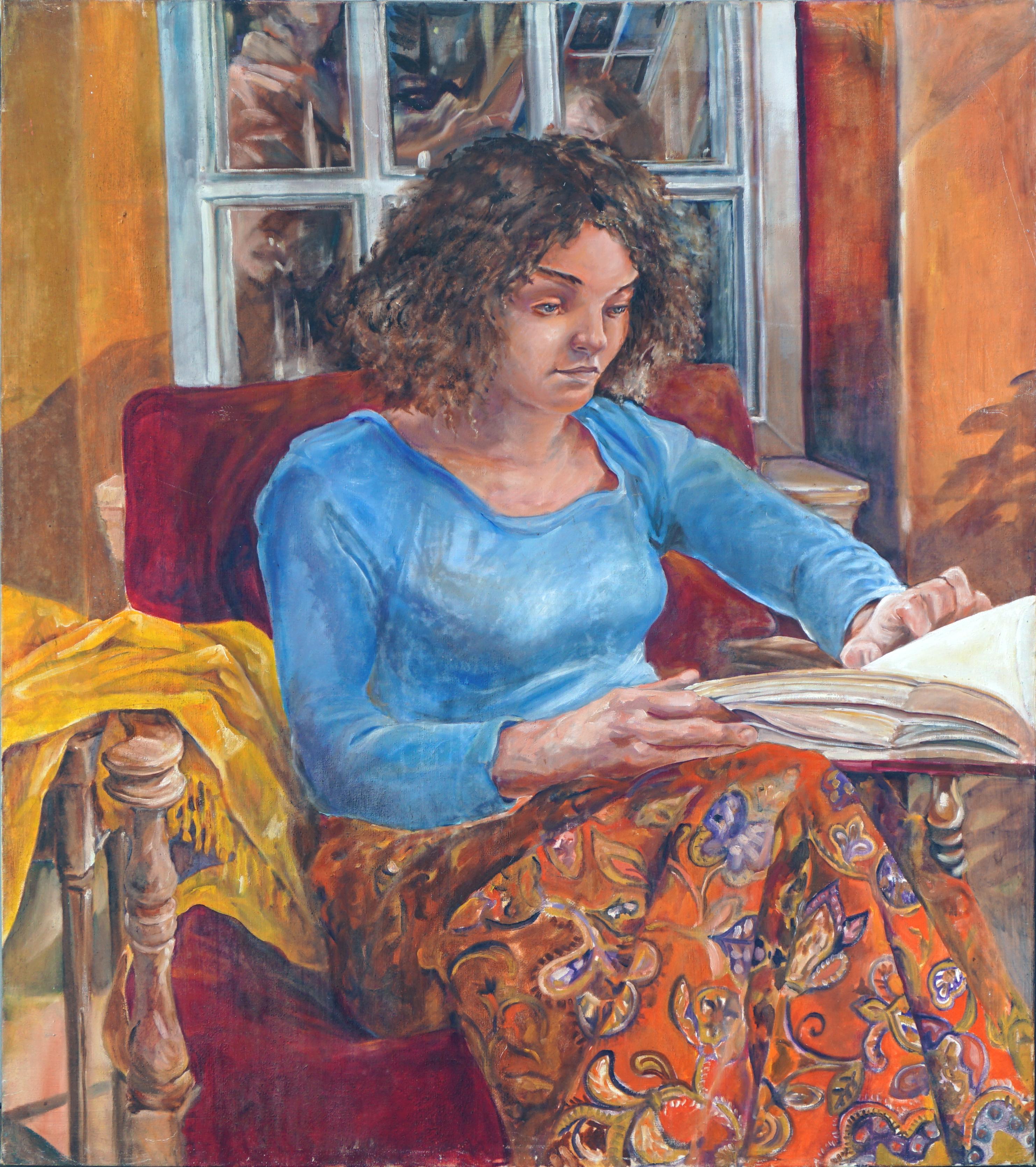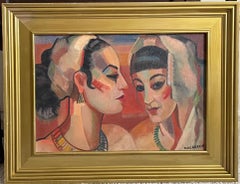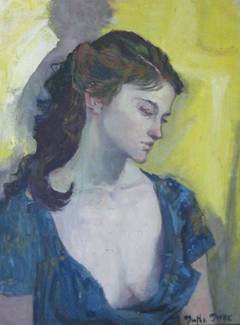
Portrait of a Young Woman
View Similar Items
Want more images or videos?
Request additional images or videos from the seller
1 of 3
Martha MoorePortrait of a Young Woman1940
1940
About the Item
- Creator:Martha Moore (1912 - 1982, American)
- Creation Year:1940
- Medium:
- Movement & Style:
- Period:
- Condition:
- Gallery Location:Los Angeles, CA
- Reference Number:1stDibs: LU39450842
About the Seller
5.0
Vetted Seller
These experienced sellers undergo a comprehensive evaluation by our team of in-house experts.
Established in 1972
1stDibs seller since 2011
384 sales on 1stDibs
More From This SellerView All
- Lady in the Paris ParkLocated in Los Angeles, CABeautiful young lady in a Paris Park, signed, Original Frame, listed size includes the frame.Category
1950s Impressionist Figurative Paintings
MaterialsPanel, Oil
$788 Sale Price49% Off - AlexandriaBy Buckley MacGurrinLocated in Los Angeles, CABUCKLEY MACGURRIN "ALEXANDRIA" OIL ON CANVAS, SIGNED, TITLED AMERICAN, DATED 1949 EXHIBITED: DALZELL-HATFIELD GALLERY 14 X 20 INCHES Buckley MacGurrin 1896 –1971 Buckley MacG...Category
1940s Art Deco Figurative Paintings
MaterialsOil, Canvas
- BLONDE WITH ART DECO NECKLACELocated in Los Angeles, CABiography from the niece of the artist from during his lifetime. Paintings acquired from the artist.s estate. Max Turner 1925 - 2019 Max Lamar Turner Painter, Sculptor, Teacher and Author. Max Turner was born in Omaha, Nebraska on July 28, 1925. His father was Lance Howard Turner and his mother Mary Irene Turner. In 1927, his family moved to Bingham Canyon, Utah where Max's father extracted copper from a creek that he had diverted to pass through his garage. The town was located in a narrow canyon on the eastern face of the Oquirrh Mountains. In 1938, when Max was 13, his family moved to Midvale, Utah. After completing high school, Max went to work laying rail until he was inducted into the U.S. Navy to serve during W.W. II. There he took an aptitude test and was initially assigned to the medical corp., later transferring to the dental unit. Max was stationed at Port Hueneme, Ventura County, California through the end of the war. When he was discharged in 1946, he remained in Southern California, living in the Los Angeles area. He met a man named Larry Torres and they formed a partnership to do silk screen work primarily for the Colby Poster Printing Company. This lasted about 10 years until the Colby building caught fire and burned down. In 1958, Max began working for Slade Novelty company that made doll parts using a product called plastisol. A year later, Max began producing plastic parts through his own business. One day, a couple of kids brought in a shrunken skull they had made and asked Max if he could reproduce it. Max said he could and he looked around for a business to work with for this task. He ultimately decided he could create his own machine shop to make molds. As a result, Max purchased a lathe, drill press, grinder and other tools to create his own machine shop and went into business making molds. He built a clientele and in 1973, he moved his machine shop to Glendale, California. Painter, Sculptor, Teacher and Author: Max recalls the day when his interest in art took a new direction. He happened to be in a paint store to purchase some supplies when he saw a card posted on a wall that read, "Come paint with Connie Marlo". Max had been interested in art since his youth and he was frequently impressed with paintings displayed by local artists at various community events. Consequently, he decided to go to Connie's Saturday morning art class at a studio on North La Brea Avenue (between Sunset and Hollywood) in Los Angeles. But, as fate would have it, he immediately took a detour from this class when he found a piece of paper on the floor of the studio referencing another art class dealing with compositions, patterns, rhythms and color harmony. The instructor's name was Hal Reed, a former art student of the Russian/American Master, Nicolai Fechin. Hal owned the building (previously the Will Foster Studio) and had founded the Art League of Los Angeles. When Max found Hal, he asked Hal if he could join his class. Hal said "No, the class was full" but he said Max could monitor the class in the back of the classroom. Max took him up on the offer and began observing the weekly class. During the class, Hal told his students that they should practice what they were learning by going to "live model" classes. Max began attending these classes where he learned how to draw figures. After a few months, Hal and Max became good friends. Hal was so impressed with Max's work that he offered Max the opportunity to teach at another location that Hal was opening in the San Fernando Valley. Max accepted the offer and began teaching his own art class. For Max, it was a quick jump from learning to teaching. Max then found that several of his students had to commute to his art class from the west end of the "Valley". To better serve this group of students, Max decided to relocate to another studio in Calabasas. Max continued teaching, and at this time he was producing very impressive portraits, both oil paintings and charcoal drawings from live models (Max never worked from photos). Max demonstrated real talent, and the style of his drawings and paintings were being compared to those of Nicolai Fechin. And, like Fechin, Max also had an interest in sculpting. One day, Max decided to design and cast a bronze owl sculpture to put in his Calabasas Fine Art Gallery. Later, someone approached Max when he was at the foundry and asked him about his success selling the owl sculpture. The individual who asked this question was convinced that there was a broader market for these sculptures and he ordered a dozen of the owl sculptures from Max. This encouraged Max to do more castings. Some of the new castings were antique sculptures he found and reproduced. As this new business grew, he decided to establish his own foundry, employing up to 15 workers. The business continued for many years, up until the late 1990's when Max got tired of the foundry business and sold it. Max, who was now in his 70's, decided to move on to his next venture as an artist, dedicating himself to doing the actual sculpting of original art. He loved the creativity of sculpting and he had his sculptures cast at local foundries, ironically the same ones that used to be his competition. Max was now fully engaged in his new artistic direction and, over time, he produced a large body of work. He created very impressive sculptures, including about 100 full-size sculptures. He sold some of these to high-end clientele, the Foundry at SLS Las Vegas, and to Hollywood studios. Even though Max now seemed to be totally in his element, he somehow also found time to continue to teach painting classes at the California Art Institute in Westlake Village in Los Angeles. At the institute, he specialized in figure work. Max continued to draw, paint and teach, but he says he stopped sculpting when he turned 90. Max produced four books showcasing his drawings and paintings. The first is "Faces, The Drawings of Max Turner", copyright 2000, that showcases nearly 100 of his portrait drawings. Within the "Acknowledgements" section, he lists Hal Reed and Joseph Nordmann, two former students of Nicolai Fechin. In 2006, Max produced his second book titled "Figures and Faces", reflecting not only portraits but also figure drawings and paintings. It is a wonderful book of Max's work, but it is currently difficult to find. The third book is titled "Faces 2, The Paintings and Drawings of Max Turner", copyright 2009, which includes 75 portrait paintings and drawings. In the "Preface" of this book, Max describes growing up in a small and isolated mining town during the Great Depression. He states that as a kid, he had little exposure of any culture or view of what the rest of the world was like. His neighbor was the trash collector and Max would sometimes go through his truck looking for anything of value. Among other things, he found magazines like Cosmopolitan, Good Housekeeping and Red Book, with covers that frequently showed drawings or paintings of faces. Max states that these images were the very first source of inspiration for him. He says that he began looking more carefully at people's faces and if they had character, he would draw them. By drawing them, Max says that he was making them part of his world, his world of "Faces". In 2018, Max published his newest book showcasing his drawings and paintings. It is titled "Max Turner's Figure Sketches". This softbound book includes 76 pages and over 120 drawings and paintings. In the Introduction, Max explains "I have found that when approaching the figure, one should begin with the gesture. After having captured the essence or feeling of the pose, one can then proceed to build on it." The figure sketches in this wonderful book reflect a Master's work that consistently captures the "gesture"-showing the emotion, movement and expression. Two more books are on the horizon for Max, both dealing with his passion for sculpting. His first, "The Sculpture of Max Turner" is a compilation of his commercial and noncommercial pieces throughout his career. The second, "Terra Cotta Sculpture by Max Turner" is a complete collection of figures done at the California Art Institute. These much anticipated books should be out later in 2018. Max now considers himself primarily a sculptor. But others in the art world are more than impressed with his drawings and paintings as well. His portraits are often described as having a Fechin-esque appearance, referring to the style of Nicolai Fechin. When Max observed those first art classes given by Hal Reed, it should be noted that Hal had previously been a student of the Russian/American Master Nicolai Fechin in the early to mid-1950's. In fact, Hal was a student in the last art class that Fechin taught before he unexpectedly died in 1955. Hal was so strongly influenced by Fechin that he later produced two 30-minute art instruction videos as part his Art Video Productions wherein he specifically described Fechin techniques that he learned in Fechin's class. The Fechin style and techniques were in play when Max later met Hal. Over the years, many of Max's art students, art collectors, gallery owners, as well as the Director of the Monterey Museum of Art have commented on the Fechin-esque qualities of Max's wonderful charcoal drawings and paintings. So, while Max may consider himself primarily a sculptor, his drawings and paintings are also impressive and very much sought after. When Nicolai Fechin died in 1955, three of the nine students in his last art class became life-long friends. Max subsequently became friends with not only Hal Reed, but also with prior Fechin students Joseph Nordmann and Albert Londraville...Category
1990s Modern Figurative Paintings
MaterialsOil, Canvas
$650 Sale Price48% Off - LADY WITH PICK FANLocated in Los Angeles, CABiography from the niece of the artist from during his lifetime. Paintings acquired from the artist.s estate. Max Turner 1925 - 2019 Max Lamar Turner Painter, Sculptor, Teacher and Author. Max Turner was born in Omaha, Nebraska on July 28, 1925. His father was Lance Howard Turner and his mother Mary Irene Turner. In 1927, his family moved to Bingham Canyon, Utah where Max's father extracted copper from a creek that he had diverted to pass through his garage. The town was located in a narrow canyon on the eastern face of the Oquirrh Mountains. In 1938, when Max was 13, his family moved to Midvale, Utah. After completing high school, Max went to work laying rail until he was inducted into the U.S. Navy to serve during W.W. II. There he took an aptitude test and was initially assigned to the medical corp., later transferring to the dental unit. Max was stationed at Port Hueneme, Ventura County, California through the end of the war. When he was discharged in 1946, he remained in Southern California, living in the Los Angeles area. He met a man named Larry Torres and they formed a partnership to do silk screen work primarily for the Colby Poster Printing Company. This lasted about 10 years until the Colby building caught fire and burned down. In 1958, Max began working for Slade Novelty company that made doll parts using a product called plastisol. A year later, Max began producing plastic parts through his own business. One day, a couple of kids brought in a shrunken skull they had made and asked Max if he could reproduce it. Max said he could and he looked around for a business to work with for this task. He ultimately decided he could create his own machine shop to make molds. As a result, Max purchased a lathe, drill press, grinder and other tools to create his own machine shop and went into business making molds. He built a clientele and in 1973, he moved his machine shop to Glendale, California. Painter, Sculptor, Teacher and Author: Max recalls the day when his interest in art took a new direction. He happened to be in a paint store to purchase some supplies when he saw a card posted on a wall that read, "Come paint with Connie Marlo". Max had been interested in art since his youth and he was frequently impressed with paintings displayed by local artists at various community events. Consequently, he decided to go to Connie's Saturday morning art class at a studio on North La Brea Avenue (between Sunset and Hollywood) in Los Angeles. But, as fate would have it, he immediately took a detour from this class when he found a piece of paper on the floor of the studio referencing another art class dealing with compositions, patterns, rhythms and color harmony. The instructor's name was Hal Reed, a former art student of the Russian/American Master, Nicolai Fechin. Hal owned the building (previously the Will Foster Studio) and had founded the Art League of Los Angeles. When Max found Hal, he asked Hal if he could join his class. Hal said "No, the class was full" but he said Max could monitor the class in the back of the classroom. Max took him up on the offer and began observing the weekly class. During the class, Hal told his students that they should practice what they were learning by going to "live model" classes. Max began attending these classes where he learned how to draw figures. After a few months, Hal and Max became good friends. Hal was so impressed with Max's work that he offered Max the opportunity to teach at another location that Hal was opening in the San Fernando Valley. Max accepted the offer and began teaching his own art class. For Max, it was a quick jump from learning to teaching. Max then found that several of his students had to commute to his art class from the west end of the "Valley". To better serve this group of students, Max decided to relocate to another studio in Calabasas. Max continued teaching, and at this time he was producing very impressive portraits, both oil paintings and charcoal drawings from live models (Max never worked from photos). Max demonstrated real talent, and the style of his drawings and paintings were being compared to those of Nicolai Fechin. And, like Fechin, Max also had an interest in sculpting. One day, Max decided to design and cast a bronze owl sculpture to put in his Calabasas Fine Art Gallery. Later, someone approached Max when he was at the foundry and asked him about his success selling the owl sculpture. The individual who asked this question was convinced that there was a broader market for these sculptures and he ordered a dozen of the owl sculptures from Max. This encouraged Max to do more castings. Some of the new castings were antique sculptures he found and reproduced. As this new business grew, he decided to establish his own foundry, employing up to 15 workers. The business continued for many years, up until the late 1990's when Max got tired of the foundry business and sold it. Max, who was now in his 70's, decided to move on to his next venture as an artist, dedicating himself to doing the actual sculpting of original art. He loved the creativity of sculpting and he had his sculptures cast at local foundries, ironically the same ones that used to be his competition. Max was now fully engaged in his new artistic direction and, over time, he produced a large body of work. He created very impressive sculptures, including about 100 full-size sculptures. He sold some of these to high-end clientele, the Foundry at SLS Las Vegas, and to Hollywood studios. Even though Max now seemed to be totally in his element, he somehow also found time to continue to teach painting classes at the California Art Institute in Westlake Village in Los Angeles. At the institute, he specialized in figure work. Max continued to draw, paint and teach, but he says he stopped sculpting when he turned 90. Max produced four books showcasing his drawings and paintings. The first is "Faces, The Drawings of Max Turner", copyright 2000, that showcases nearly 100 of his portrait drawings. Within the "Acknowledgements" section, he lists Hal Reed and Joseph Nordmann, two former students of Nicolai Fechin. In 2006, Max produced his second book titled "Figures and Faces", reflecting not only portraits but also figure drawings and paintings. It is a wonderful book of Max's work, but it is currently difficult to find. The third book is titled "Faces 2, The Paintings and Drawings of Max Turner", copyright 2009, which includes 75 portrait paintings and drawings. In the "Preface" of this book, Max describes growing up in a small and isolated mining town during the Great Depression. He states that as a kid, he had little exposure of any culture or view of what the rest of the world was like. His neighbor was the trash collector and Max would sometimes go through his truck looking for anything of value. Among other things, he found magazines like Cosmopolitan, Good Housekeeping and Red Book, with covers that frequently showed drawings or paintings of faces. Max states that these images were the very first source of inspiration for him. He says that he began looking more carefully at people's faces and if they had character, he would draw them. By drawing them, Max says that he was making them part of his world, his world of "Faces". In 2018, Max published his newest book showcasing his drawings and paintings. It is titled "Max Turner's Figure Sketches". This softbound book includes 76 pages and over 120 drawings and paintings. In the Introduction, Max explains "I have found that when approaching the figure, one should begin with the gesture. After having captured the essence or feeling of the pose, one can then proceed to build on it." The figure sketches in this wonderful book reflect a Master's work that consistently captures the "gesture"-showing the emotion, movement and expression. Two more books are on the horizon for Max, both dealing with his passion for sculpting. His first, "The Sculpture of Max Turner" is a compilation of his commercial and noncommercial pieces throughout his career. The second, "Terra Cotta Sculpture by Max Turner" is a complete collection of figures done at the California Art Institute. These much anticipated books should be out later in 2018. Max now considers himself primarily a sculptor. But others in the art world are more than impressed with his drawings and paintings as well. His portraits are often described as having a Fechin-esque appearance, referring to the style of Nicolai Fechin. When Max observed those first art classes given by Hal Reed, it should be noted that Hal had previously been a student of the Russian/American Master Nicolai Fechin in the early to mid-1950's. In fact, Hal was a student in the last art class that Fechin taught before he unexpectedly died in 1955. Hal was so strongly influenced by Fechin that he later produced two 30-minute art instruction videos as part his Art Video Productions wherein he specifically described Fechin techniques that he learned in Fechin's class. The Fechin style and techniques were in play when Max later met Hal. Over the years, many of Max's art students, art collectors, gallery owners, as well as the Director of the Monterey Museum of Art have commented on the Fechin-esque qualities of Max's wonderful charcoal drawings and paintings. So, while Max may consider himself primarily a sculptor, his drawings and paintings are also impressive and very much sought after. When Nicolai Fechin died in 1955, three of the nine students in his last art class became life-long friends. Max subsequently became friends with not only Hal Reed, but also with prior Fechin students Joseph Nordmann and Albert Londraville...Category
1990s Modern Figurative Paintings
MaterialsOil, Canvas
$450 Sale Price64% Off - Woman with DogBy Reza AfrookhtehLocated in Los Angeles, CASize with frame: 34 x 28 Inches Reza begun studying art seriously at age 15 and was studying at the institute of art in Iran where he graduated with highest honors. He also studied...Category
Early 2000s Realist Figurative Paintings
MaterialsOil, Canvas
Price Upon Request - Man with Yellow TieLocated in Los Angeles, CAALEXANDER KREISEL "MAN WITH YELLOW TIE" OIL ON CANVAS BOARD, SIGNED RUSSIAN-AMERICAN, C.1935 26 X 19.5 INCHES FRAMED 29.5 X 23.5 INCHES Alexander Krei...Category
1930s Expressionist Figurative Paintings
MaterialsOil, Canvas
$1,688 Sale Price24% Off
You May Also Like
- At Doug's PlaceBy Lu HaskewLocated in Loveland, COAt Doug's Place by Lu Haskew Oil 12x10" image size Plein Air artists sit by a river discussing on break from the day of painting. ABOUT THE ARTIST: Lu considered it a must to work...Category
Early 2000s American Impressionist Figurative Paintings
MaterialsCanvas, Oil
- Take Me HomeBy Lu HaskewLocated in Loveland, CO"Take me Home" by Lu Haskew Oil 19x16" framed, 12x8" image size Signed lower left A young child very apparently ready to go home from their intense yet cute look. The child is weari...Category
Early 2000s American Impressionist Figurative Paintings
MaterialsCanvas, Oil
$450 Sale Price43% Off - "The Pensive Beauty, " Carl Nordell, American Impressionism, Female PortraitBy Carl NordellLocated in New York, NYCarl Nordell (1885 - 1957) The Pensive Beauty Oil on canvas 40 x 32 inches Signed lower left Nordell was born in Copenhagen on 23 September 1885. In 1892 the Nordell family settled in Westerly, New Jersey, where Carl Johan, one of several children, received his education. Reportedly, a local gambler and art collector, Richard Canfield was so impressed with young Nordell's talent that he assisted him to gain admittance to the Rhode Island School of Design. Carl was a tireless student and serious in his studies of art, literature, and philosophy. Friends nicknamed him "The American Frans Hals," as a result of his study of that Dutch master. After graduating from the school in 1905, Nordell continued his training at the Art Students League in New York City for the following two years. There he received criticism and instruction from George Bridgman (1864-1943), a noted teacher of anatomy, and Frank Vincent DuMond (1865-1951), a landscapist associated with Old Lyme. The popularity of Impressionism in America at this time had reached its peak, and the style was of paramount influence in Nordell's advanced studies. Around 1906, Nordell visited an exhibition of paintings by the Ten, most of whom were American Impressionists. Moved by the work of Tarbell and Joseph R. De Camp, he sought instruction from them at the School of the Museum of Fine Arts, Boston. Nordell worked diligently under Tarbell and experimented with the genre of women in interiors, or Intimism. In 1909, Nordell received the Paige Traveling Scholarship, which provided for two years of continued study in Europe. He became one of the hundreds of Americans to receive criticism from Jean-Paul Laurens at the Académie Julian in Paris. From this base, he made study trips to visit major museums and galleries in Italy, Holland, Spain and Germany and during this period Nordell's style reached a level of uniqueness, though he definitely remained under the general influence of French Impressionism. By the time of his return to Boston in 1911, Nordell had successfully incorporated the use of broken color, a high-keyed palette, and the practice of working en plein air to achieve an accurate representation of light and atmosphere. In October of that year, the Boston Art Club presented eighty-seven of Nordell's watercolors and oils to the viewing public. Some of the watercolors seem revolutionary in their spontaneity. Nordell continued his career in Boston at Fenway Studios and exhibited in national competitions, including the annuals of the National Academy of Design, the Art Institute of Chicago; at the 1912 biennial of the Corcoran Gallery he won the fourth Clarke Prize. Nordell's finances were augmented by portrait commissions of some of Boston's affluent citizens. The artist was so intent on recording the sitter's likeness that in this genre, he deviated from his usual impressionist technique. In the women-in-interior genre, he frequently depicted a fully draped woman seated in profile or at an oblique angle to the picture plane. These pensive and attractive young ladies usually gaze into space and become an integral part of the pleasant ambiance of the scene. In this way, Nordell remained within the Genteel Tradition as it was manifest in Boston. The artist exhibited several such works in the Panama-Pacific International Exposition in San Francisco in 1915, and won a silver medal for his efforts. In 1918, a one-man exhibition of fifty works was presented at the Boston Art Club. Nordell remained active in the Boston area art clubs and societies through the early 1920s. In the winter of 1921 Babcock Art Galleries presented him with yet another one-man show. During this period, Nordell increased the production of prints and won the Salmagundi Club's Shaw Prize for etching in 1923. Sometime after 1927 he began taking summer sketching trips to Chautauqua Lake...Category
Early 20th Century American Impressionist Figurative Paintings
MaterialsCanvas, Oil
- "The Red Dress"By Joseph NewmanLocated in Lambertville, NJJim’s of Lambertville is proud to offer this artwork by: Joseph Newman (1890 - 1979) Joseph Newman was born in New York City in 1890. He attended the Pratt Institute and the Adelphi College Art School, and served in the U.S. Army during WWW1. After the war, he married and traveled to Europe. He returned to New York in the mid 1920's, and with a group of contemporaries formed The Fifteen Gallery in Manhattan. Newman painted a broad variety of subjects including genre scenes, landscapes, figurative works, and equestrian subjects. He worked in various styles ranging from academic realism to a looser, post-impressionist approach, and is best known for colorful, animated genre scenes painted in and around Rockport Harbor and as far west as Taos, New Mexico. He exhibited frequently at the Brooklyn Museum, The National Academy, The Carnegie Institute, The Whitney and The Society of Independent Artists. He was a member of the L.C. Tiffany Foundation, The Salmagundi Club, Rockport Art Association, and the American Watercolor Society. His work is represented in the collections of the Brooklyn Museum, The Newark Museum, the Boston Library...Category
20th Century American Impressionist Figurative Paintings
MaterialsCanvas, Oil
$45,625 - Tea Time Figurative in Original Oil on CanvasBy Patricia GillfillanLocated in Soquel, CATea Time Figurative in Original Oil on Canvas Charming portrait of a young woman enjoying tea time by Patricia Gillfillan (American, 1924-2016). From a collection of her works. Unsig...Category
1980s American Impressionist Figurative Paintings
MaterialsCanvas, Oil
- Mid Century Portrait of a Clown #5By Marjorie May BlakeLocated in Soquel, CAMid century portrait of a clown by Marjorie Blake (American, 1920-1994). Signed "Blake" in the lower left corner. Unframed. Marjorie May Gulley Blake w...Category
1960s American Impressionist Figurative Paintings
MaterialsCanvas, Oil
$316 Sale Price20% Off
Recently Viewed
View AllMore Ways To Browse
African Canadian
Seventeenth Century Paintings
Soviet Oil Painting
Vintage Army Man
A La Francaise
Circus Canvas
The Book Lady
Spanish Village
Woman With Horse
Dutch Modern Figurative Art
French Impressionist Paintings Of Women
Versailles Painting
The Ballerina Painting
John Lurie
Dutch Genre Paintings
Classic English Paintings
Painting Classical Greece
Donkey Art
